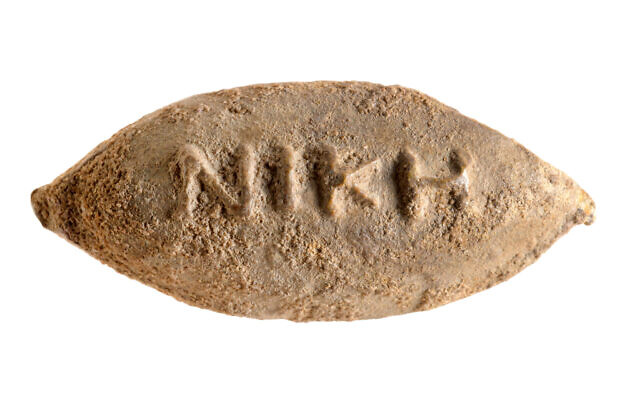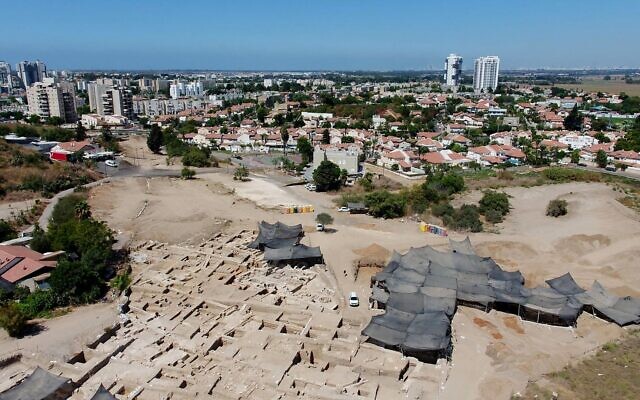Some 2,200 years ago, a Greek soldier stood in battle in what is now the Israeli city of Yavne, aimed his sling at Jewish Hasmonean troops, and launched a projectile at them during battles that would later become part of the story of Hanukkah.
At least, that is one option suggested following the discovery in Yavne of a sling bullet made of lead and bearing a Greek inscription reading “Victory for Heracles and Hauron” — a possible attempt at psychological warfare against enemies.
The Israel Antiquities Authority, which revealed the finding, told The Times of Israel that the sling bullet was discovered about a year ago and has been studied since then. It timed the announcement for Wednesday, 10 days before Hanukkah.
The IAA said in a statement that the sling bullet found in Yavne’s major archaeological site is 4.4 centimeters (1.7 inches) long and around 2,200 years old. Its age places it around the time of the battles between the Seleucid army against the Hasmoneans, who were seeking to prevent the Hellenization of the Jews.
The researchers, however, acknowledged that it isn’t known in what context the slingshot was used, and that there was no conclusive evidence that it even belonged to a Greek soldier.
Get The Times of Israel's Daily Edition by email and never miss our top stories
“It seems that we will not be able to know for sure if the sling bullet belonged to a Greek soldier, but it is not impossible that it is related to the conflict between the Greeks and the Hasmoneans,” said Pablo Betzer and Dr. Daniel Varga, who directed the excavation on behalf of the IAA, in the statement.

The word “Victory” on a sling bullet found in Yavne. (Dafna Gazit/Israel Antiquities Authority)
“The tiny lead sling bullets, announcing the imminent victory of the gods of pagan Yavne, is tangible evidence of a fierce battle that took place in Yavne at that time,” they added.
According to Prof. Yulia Ustinova of Ben Gurion University, who deciphered the inscription, “the pair of gods Hauron and Heracles were considered the divine patrons of Yavne during the Hellenistic period. The inscription on a sling bullet is the first archaeological evidence of the two guardians of Yavne, discovered inside Yavne itself. Until today, the pair was only known from an inscription on the Greek island of Delos.”
Ustinova said the inscription wasn’t a simple call for the deities’ help, but “a threat directed towards adversaries.
“Lead sling bullets are known in the ancient world, beginning in the 5th century BCE, but few individual sling bullets with inscriptions have been found in Israel,” she added. “The inscriptions convey a message of unifying the warriors with the aim of raising their spirits, scaring the enemy, or a call intended to magically energize the sling bullet itself. These inscriptions were part of psychological warfare, the main purpose of which is to terrorize the opponent, and in addition, to unite the warriors and raise their spirits.”

The archaeological site in Yavne, with the city in the background, in an undated photo released on December 8, 2022. (Assaf Peretz/Israel Antiquities Authority)
“One can only imagine what that warrior who held the sling bullet 2,200 years ago thought and felt, as he held on to the hope of divine salvation,” said IAA director Eli Escusido.
The IAA said the excavations in Yavne are carried out as part of an Israel Land Authority initiative to expand the city, in cooperation with the municipality.
The IAA said the finding and its story will be presented to the public next Tuesday in a free event titled “Yavne and its Secrets” to be held in the city’s culture hall.


